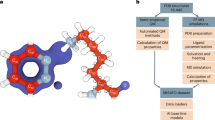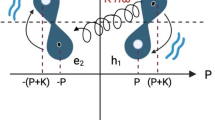Abstract
Halogen bonds (X-bonds) are shown to be geometrically perpendicular to and energetically independent of hydrogen bonds (H-bonds) that share a common carbonyl oxygen acceptor. This orthogonal relationship is accommodated by the in-plane and out-of-plane electronegative potentials of the oxygen, which are differentially populated by H- and X-bonds. Furthermore, the local conformation of a peptide helps to define the geometry of the H-bond and thus the oxygen surface that is accessible for X-bonding. These electrostatic and steric forces conspire to impose a strong preference for the orthogonal geometry of X- and H-bonds. Thus, the optimum geometry of an X-bond can be predicted from the pattern of H-bonds in a folded protein, enabling X-bonds to be introduced to improve ligand affinities without disrupting these structurally important interactions. This concept of orthogonal molecular interactions can be exploited for the rational design of halogenated ligands as inhibitors and drugs, and in biomolecular engineering.
This is a preview of subscription content, access via your institution
Access options
Subscribe to this journal
Receive 12 print issues and online access
$259.00 per year
only $21.58 per issue
Buy this article
- Purchase on Springer Link
- Instant access to full article PDF
Prices may be subject to local taxes which are calculated during checkout





Similar content being viewed by others
References
Barany, G. & Merrifield, R. B. A new amino protecting group removable by reduction. Chemistry of the dithiasuccinoyl (Dts) function. J. Am. Chem. Soc. 99, 7363–7365 (1977).
Burley, S. K. & Petsko, G. A. Aromatic–aromatic interaction: a mechanism of protein structure stabilization. Science 229, 23–28 (1985).
Burley, S. K. & Petsko, G. A. Amino-aromatic interactions in proteins. FEBS Lett. 203, 139–143 (1986).
Paulini, R., Muller, K. & Diederich, F. Orthogonal multipolar interactions in structural chemistry and biology. Angew. Chem. Int. Ed. 44, 1788–1805 (2005).
Metrangolo, P. & Resnati, G. Halogen versus hydrogen. Science 321, 918–919 (2008).
Hassel, O. Structural aspects of interatomic charge-transfer bonding. Science 17, 497–502 (1970).
Legon, A. C. Prereactive complexes of dihalogens XY with Lewis bases B in the gas phase: a systematic case for the halogen analogue B···XY of the hydrogen bond B···HX. Angew. Chem. Int. Ed. 38, 2686–2714 (1999).
Rose, G. D. & Wolfenden, R. Hydrogen bonding, hydrophobicity, packing, and protein structure. Annu. Rev. Biophys. Biomol. Struct. 22, 381–415 (1993).
Baldwin, R. L. In search of the energetic role of peptide hydrogen bonds. J. Biol. Chem. 278, 17581–17588 (2003).
Brinck, T., Murray, J. S. & Politzer, P. Surface electrostatic potentials of halogenated methanes as indicators of directional intermolecular interactions. Int. J. Quantum Chem. 44 (S19), 57–64 (1992).
Lommerse, J. P. M., Stone, A. J., Taylor, R. & Allen, F. H. The nature and geometry of intramolecular interactions between halogens and oxygen or nitrogen. J. Am. Chem. Soc. 118, 3108–3116 (1996).
Metrangolo, P. & Resnati, G. Halogen bonding: a paradigm in supramolecular chemistry. Chem. Eur. J. 7, 2511–2119 (2001).
Auffinger, P., Hays, F. A., Westhof, E. & Ho, P. S. Halogen bonds in biological molecules. Proc. Natl Acad. Sci. USA 101, 16789–16794 (2004).
Clark, T., Hennemann, M., Murray, J. S. & Politzer, P. Halogen bonding: the sigma-hole. J. Mol. Model. 13, 291–296 (2007).
Corradi, E., Meille, S. V., Messina, M. T., Metrangolo, P. & Resnati, G. Halogen bonding versus hydrogen bonding in driving self-assembly processes. Angew. Chem. Int. Ed. 39, 1782–1786 (2000).
Voth, A. R., Hays, F. A. & Ho, P. S. Directing macromolecular conformation by halogen bonds. Proc. Natl Acad. Sci. USA 104, 6188–6193 (2007).
Politzer, P., Murray, J. S. & Lane, P. Sigma-hole bonding and hydrogen bonding: competitive interactions. Int. J. Quantum Chem. 107, 3046–3052 (2007).
Lu, Y. X., Zou, J. W., Wang, Y. H., Jiang, Y. J. & Yu, Q.S. Ab initio investigation of the complexes between bromobenzene and several electron donors: Some insights into the magnitude and nature of halogen bonding interactions. J. Phys. Chem. A 111, 10781–10788 (2007).
Fain, A. V., Berezovskii, I. N., Tchehov, V. O., Ukrainskii, D. L. & Esipova N.G. Double and bifurkated bonds in alpha-helices of globular proteins. Biofizika (Rus.) 46, 969–977 (2001).
Sun, A., Lauher, J. W. & Goroff, N. S., Preparation of poly(diiododiacetylene), an ordered conjugated polymer of carbon and iodine. Science 312, 1030–1034 (2006).
Aakeröy, C. et al. Combining halogen bonds and hydrogen bonds in the modular assembly of heteromeric infinite 1-D chains. Chem. Commun. 4236–4238 (2007).
Schmidt, J. R. & Polik, W.F. WebMO <http://www.webmo.net> (2005).
Schmidt, M. W. K. et al. General atomic and molecular electronic structure system. J. Comput. Chem. 14, 1347–1363 (1993).
Voth, A. R. & Ho, P. S. The role of halogen bonding in inhibitor recognition and binding by protein kinases. Curr. Top. Med. Chem. 7, 1336–1348 (2007).
Berman, H. M. et al. The protein data bank. Nucleic Acids Res. 28, 235–242 (2000).
Acknowledgements
We thank Maximiliano Vallejos and the 2005 Biophysics class at Oregon State University for their help in the ab initio calculations. We also thank P. Andrew Karplus for helpful discussion. This work was funded in part by grants from the National Institutes of Health (RIGM62957) and from the Oregon Medical Research Foundation.
Author information
Authors and Affiliations
Contributions
A.R.V. and P.K. contributed equally to this work. P.S.H., A.R.V. and P.K. analysed and interpreted results, and contributed to writing the manuscript. K.O. performed calculations for this study.
Corresponding author
Rights and permissions
About this article
Cite this article
Voth, A., Khuu, P., Oishi, K. et al. Halogen bonds as orthogonal molecular interactions to hydrogen bonds. Nature Chem 1, 74–79 (2009). https://doi.org/10.1038/nchem.112
Received:
Accepted:
Published:
Issue Date:
DOI: https://doi.org/10.1038/nchem.112
This article is cited by
-
Competition between electrostatic interactions and halogen bonding in the protein–ligand system: structural and thermodynamic studies of 5,6-dibromobenzotriazole-hCK2α complexes
Scientific Reports (2022)
-
Unravelling the Importance of H bonds, σ–hole and π–hole-Directed Intermolecular Interactions in Nature
Journal of the Indian Institute of Science (2020)
-
Molecular docking and pharmacophoric modelling of 1,5-disubstituted tetrazoles as inhibitors of two proteins present in cancer, the ABL and the mutated T315I kinase
In Silico Pharmacology (2020)
-
Structure-based lead optimization to improve the antifungal potency of the tetrahydroimidazo pyridine inhibitors targeted to Candida albicans dihydrofolate reductase and lanosterol 14-alpha-demethylase
Medicinal Chemistry Research (2019)
-
Effect of external electric field on C–X ··· π halogen bonds
Journal of Molecular Modeling (2019)



